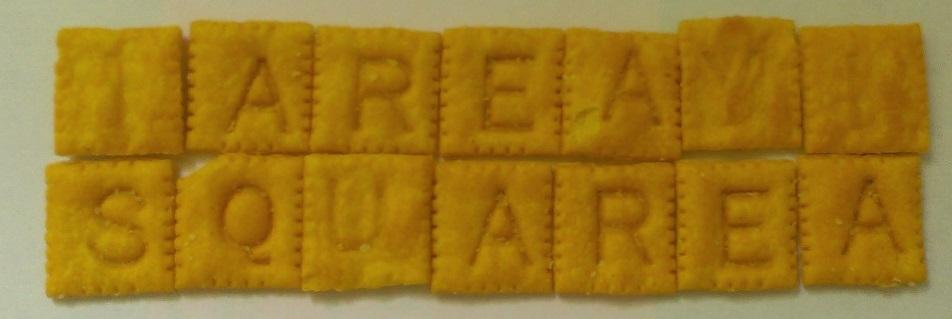Area and Perimeter of Rectangles with Cheezits - Remix 1
Factoring Whole Numbers Using Area Models of Rectangles

This work is a remix of Area and Perimeter of Rectangles Using Cheez-Its by Susan Jones and is licensed under https://creativecommons.org/licenses/by/4.0/

Cheez-It Math Area and Factors
Objectives:
This lesson corresponds to the Oregon Adult Learning Standards (OALS) and the College and Career Readiness Standards as below:
Oregon Adult Learning Standards (OALS) N2.1.and P2.1c and CCRS 3.OA Interpret products of whole numbers, e.g., interpret 5 x 7 as the total number of objects in 5 groups of 7 objects each. For example, describe a context in which a total number of objects can be expressed as 5 × 7.
OALS P2.1c and CCRS 1.OA.3: Apply properties of operations as strategies to multiply and divide. Examples: If 6 × 4 = 4 × 6= 24 (Commutative property of multiplication.)
OALS G2.1f (all) and G2.1g and CCRS (3.MD.5 - MD.7): Geometric measurement: understand concepts of area and relate to area of multiplication and addition.
• A square with side length 1 unit, called “a unit square,” is said to have “one square unit” of area, and can be used to measure area.
• A plane figure which can be covered without gaps or overlaps by n unit squares is said to have an area of n square units.
• Measure areas by counting unit squares (square cm, square m, square in, square ft, and improvised units). (3.MD.6)
• Find the area of a rectangle with whole-number side lengths by tiling it, and show that the area is the same as would be found by multiplying the side lengths. (3.MD.7a)
• Multiply side lengths to find areas of rectangles with whole-number side lengths in the context of solving real world and mathematical problems, and represent whole-number products as rectangular areas in mathematical reasoning. (3.MD.7b)
Specific Lesson Objectives: Find the area of a rectangle with whole-number side lengths by tiling, show that the area is the same as would be found by multiplying the side lengths, and to provide concrete evidence of the commutative property of multiplication.
- Students will construct area models to show multiplication and have experience using manipulatives to visualize the concepts of area and multiplication as an array
- Students will build as many different rectangles as possible using a given number of Cheez-Its and explore the relationships between the area model and multiplication.
- Students will define the dimensions of their rectangles as factors of the given numbers.
- Students will list all the factors of the given numbers.
- Students will hear and use mathematical language in context including: area, prime, square, factor.
Materials needed:
- Cheez-Its (2 boxes is probably enough for a class of 24-30) - squares cut from 1" graph paper will also work of course, but they are not as much fun!
- Graph paper
Objective: Build models of different rectangles and relate the models to factors.
- Guided Practice:
- Give each student (or group) 30 Cheez-Its. Have students pull out 12 Cheez-Its and set the rest aside. Ask the students to arrange the Cheez-Its into a rectangle.
- Ask what the area is in terms of "Square Cheez-Its" or C^2. (12 C^2)
- Have students sketch their rectangle on graph paper.
- Using the same 12 Cheez-Its, challenge students to make rectangles that have different measurements, sketching on graph paper as they go.
- Ask: "Is a 3 x 4 rectangle different from a 4x3 rectangle?" Of course they are the same, simply rotated 90 degrees. Mention the commutative property of multiplication, if appropriate for the level of the class.
- Have volunteers sketch their rectangles on the board, labeling measurements.
- Tell students that the lengths of the sides are “factors” of the area number.
- Have students list all the factors for 12. (They should get 1,2,3,4,6, and 12).
- Ask students "How can we be sure we have all the possible rectangles made?" One way is to "deal out" the Cheez-Its. Start with 1 row of 12, then make 2 rows and deal out the Cheez-Its (oh, it works out evenly - 2 rows of 6). Continue with 3 rows of 4. Do we need to try 4 rows of 3? When we get to 5 rows, we have a problem since we have some left over Cheezits...5 is not a factor of 12!) And so on.
More Guided Practice: Repeat the process of making rectangles with the number of Cheezits listed below:
a) 14
b) 20
c) 28
d) 36
e) 15
f) 45
g) 17
h) 25
i) Choose your own number
Possible Discussion Points:
1. Count the number of factors for each of the numbers below. Hypothesize about numbers that have an odd number of factors.
2. Most of the time the factors are a result of rectangles that are not squares. Which numbers in the list had an area that could be arranged as a perfect square? Have students brainstorm a list of other numbers whose area would make a perfect square.
3. Problem g above is unique in that there is only one possible rectangle to be made using 17 Cheez-Its. Such numbers are called "prime." What other numbers less than 30 are prime?
Factor Data Table
| The number = the area | The factors (arranged from least to greatest) |
| 14 | |
| 20 | |
| 28 | |
| 36 | |
| 15 | |
| 45 | |
| 17 | |
| 25 | |

This work is a remix/adaptation of https://www.oercommons.org/authoring/47500-area-and-perimeter-of-rectangles-with-cheezits-rem/view by Susan Jones and is licensed under https://creativecommons.org/licenses/by/4.0/